Having a pool in your backyard is like having a personal oasis for relaxation and fun. It offers endless opportunities for enjoyment, from cooling off on a hot day to hosting poolside parties with family and friends. But amidst the joy, safety should always be a top priority. Accidents can happen, and being prepared is crucial. One of the best ways to ensure a safe swimming environment is by having a well-stocked first aid kit close at hand. This blog post will guide you through the essential items every pool owner should have in their poolside first aid kit, helping you prepare for common injuries like cuts, scrapes, and stings. We will also discuss the importance of regular checks and updates to your kit to ensure all items are in good condition and not expired. By taking these precautions, you can ensure a secure poolside experience for everyone, making your backyard oasis a place of both fun and safety.
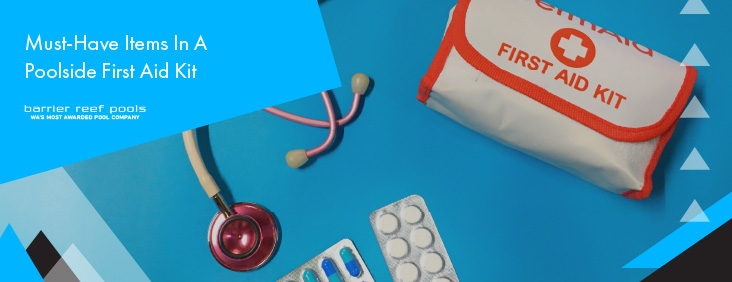
The Importance of a Poolside First Aid Kit
Accidents can happen anywhere, but the poolside poses unique risks. From minor cuts and bruises to sunburn and slips, having a first aid kit nearby can make a significant difference. Immediate access to first aid supplies allows pool owners to address injuries quickly and efficiently, reducing the severity of incidents and providing peace of mind for everyone enjoying the pool.
A well-prepared first aid kit is not just a convenience; it’s a necessity. Understanding its importance can prevent minor mishaps from turning into major issues. This article will outline the essential items you need, special considerations for poolside injuries, tips on maintaining your kit, and how to keep your pool a safe and enjoyable place for all.
Essential Items for Your Poolside First Aid Kit
Bandages and Dressings
Accidents sometimes involve cuts and scrapes, particularly around the pool’s rougher edges or hard surfaces. It’s important to stock various sizes of adhesive bandages to cover small cuts, as well as larger sterile gauze pads for more significant wounds. Adhesive tape is also essential for securing gauze pads in place and ensuring the wound is protected. By having a variety of bandages and dressings available, you can respond quickly to different types of injuries and minimise the risk of infection.
Antiseptic Wipes and Creams
Infections can easily develop if cuts and scrapes aren’t cleaned properly. Antiseptic wipes are essential for cleaning wounds and removing dirt and bacteria that could cause infection. Antiseptic creams, applied after cleaning, can help kill bacteria and promote faster healing by creating a protective barrier over the wound. These items are crucial for preventing minor injuries from becoming serious infections, ensuring that the injured area stays clean and heals properly.
Tweezers and Scissors
Tweezers are useful for removing splinters or debris from wounds, which can occur if someone accidentally steps on something sharp or falls. Having a pair of good-quality tweezers in your kit ensures you can carefully and effectively remove foreign objects from the skin. Scissors are necessary for cutting bandages and medical tape to the required size, making it easier to apply the dressings precisely. Ensure these tools are included in your kit for comprehensive care, as they can make a significant difference in the quality of first aid you can provide.
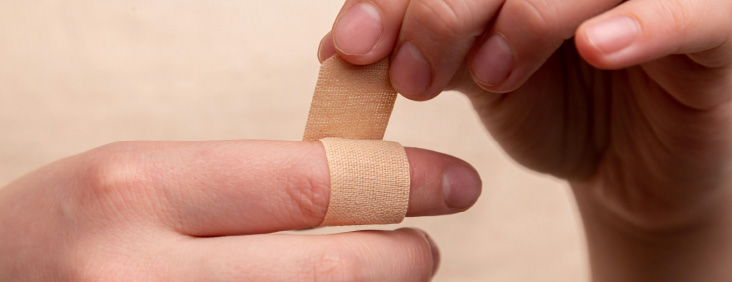
Special Considerations for Poolside Injuries
Sunburn Relief
Prolonged exposure to the sun can lead to painful sunburns. Include aloe vera gel or hydrocortisone cream in your first aid kit to soothe sunburned skin. These products help alleviate pain and reduce inflammation.
Hydration Essentials
Swimming and sunbathing can lead to dehydration. Include oral rehydration salts or electrolyte solutions in your kit to quickly address symptoms of dehydration. Keeping water bottles nearby is also a good practice.
Slips and Falls
Wet surfaces around the pool can be slippery. Have cold packs ready to treat bruises and strains that might occur due to slips and falls. Cold packs help reduce swelling and provide relief from pain.
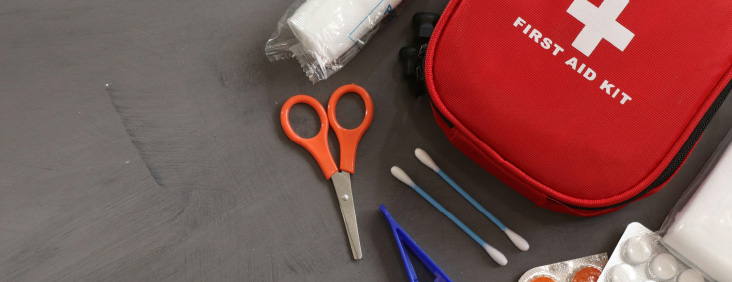
First Aid Kit Maintenance Tips
Regular Checks
Over time, the items in your first aid kit can expire or become unusable. Medications can lose their potency, bandages can become frayed, and other items may deteriorate. Schedule regular checks, at least once every three months, to ensure all items are in good condition. Review expiration dates, check for any signs of damage, and replace any expired or compromised products. This proactive approach can ensure your kit remains reliable and ready for any emergency.
Proper Storage
Store your first aid kit in a waterproof, easily accessible container to protect its contents from moisture and damage. It’s essential to designate a specific, easily reachable location for the kit, such as a kitchen cabinet or bathroom closet. Ensure that everyone in the household knows where the first aid kit is stored and understands how to use its contents effectively. A clearly labelled, dedicated spot for the kit not only ensures quick access during emergencies but also prevents misplacement.
Restocking After Use
Using even a single item from your first aid kit requires immediate restocking to maintain its preparedness for future emergencies. For instance, if you use a bandage or antiseptic wipe, make a note of the used supplies and replenish them as soon as possible. Keeping an inventory list inside the kit can be helpful for tracking what items need replacement. This diligence ensures that your first aid kit is always fully stocked and ready to handle any situation that arises.
Conclusion
A well-stocked poolside first aid kit is essential for responsible pool ownership. By preparing for common poolside injuries like minor cuts, scrapes, and sunburn, you ensure a safer environment for family and guests. Include items like bandages, antiseptic wipes, sunscreen, and cold packs. Regularly maintaining your kit and knowing how to use its contents provide peace of mind and allow everyone to enjoy the pool safely.
Being prepared is half the battle. Equip your poolside with a comprehensive first aid kit and maintain it regularly. Check expiration dates and replenish used items. Taking a basic first aid course can help you learn emergency procedures. Enjoy your pool knowing you’re ready for any minor mishap.
For more resources on first aid and pool safety, reach out to local health organisations or professional first aid trainers for valuable insights and guidance. Keep safety a priority, and your pool will be a source of joy and relaxation for everyone.
Having a pool in your backyard is like having a personal oasis for relaxation and fun. It offers endless opportunities for enjoyment, from cooling off on a hot day to hosting poolside parties with family and friends. But amidst the joy, safety should always be a top priority. Accidents can happen, and being prepared is crucial. One of the best ways to ensure a safe swimming environment is by having a well-stocked first aid kit close at hand. This blog post will guide you through the essential items every pool owner should have in their poolside first aid kit, helping you prepare for common injuries like cuts, scrapes, and stings. We will also discuss the importance of regular checks and updates to your kit to ensure all items are in good condition and not expired. By taking these precautions, you can ensure a secure poolside experience for everyone, making your backyard oasis a place of both fun and safety.
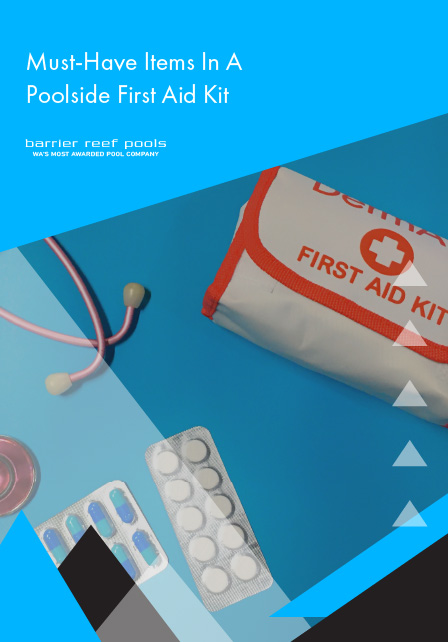
The Importance of a Poolside First Aid Kit
Accidents can happen anywhere, but the poolside poses unique risks. From minor cuts and bruises to sunburn and slips, having a first aid kit nearby can make a significant difference. Immediate access to first aid supplies allows pool owners to address injuries quickly and efficiently, reducing the severity of incidents and providing peace of mind for everyone enjoying the pool.
A well-prepared first aid kit is not just a convenience; it’s a necessity. Understanding its importance can prevent minor mishaps from turning into major issues. This article will outline the essential items you need, special considerations for poolside injuries, tips on maintaining your kit, and how to keep your pool a safe and enjoyable place for all.
Essential Items for Your Poolside First Aid Kit
Bandages and Dressings
Accidents sometimes involve cuts and scrapes, particularly around the pool’s rougher edges or hard surfaces. It’s important to stock various sizes of adhesive bandages to cover small cuts, as well as larger sterile gauze pads for more significant wounds. Adhesive tape is also essential for securing gauze pads in place and ensuring the wound is protected. By having a variety of bandages and dressings available, you can respond quickly to different types of injuries and minimise the risk of infection.
Antiseptic Wipes and Creams
Infections can easily develop if cuts and scrapes aren’t cleaned properly. Antiseptic wipes are essential for cleaning wounds and removing dirt and bacteria that could cause infection. Antiseptic creams, applied after cleaning, can help kill bacteria and promote faster healing by creating a protective barrier over the wound. These items are crucial for preventing minor injuries from becoming serious infections, ensuring that the injured area stays clean and heals properly.
Tweezers and Scissors
Tweezers are useful for removing splinters or debris from wounds, which can occur if someone accidentally steps on something sharp or falls. Having a pair of good-quality tweezers in your kit ensures you can carefully and effectively remove foreign objects from the skin. Scissors are necessary for cutting bandages and medical tape to the required size, making it easier to apply the dressings precisely. Ensure these tools are included in your kit for comprehensive care, as they can make a significant difference in the quality of first aid you can provide.
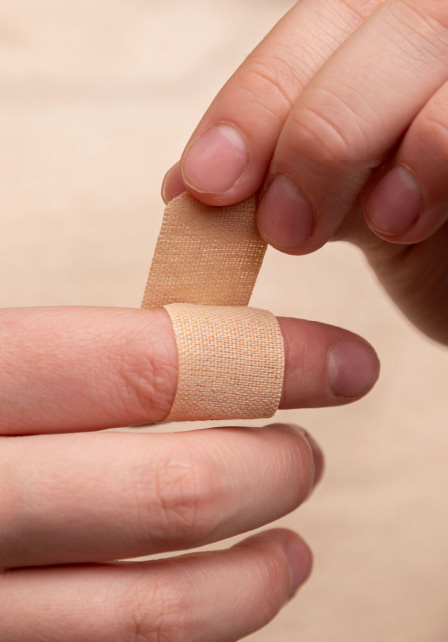
Special Considerations for Poolside Injuries
Sunburn Relief
Prolonged exposure to the sun can lead to painful sunburns. Include aloe vera gel or hydrocortisone cream in your first aid kit to soothe sunburned skin. These products help alleviate pain and reduce inflammation.
Hydration Essentials
Swimming and sunbathing can lead to dehydration. Include oral rehydration salts or electrolyte solutions in your kit to quickly address symptoms of dehydration. Keeping water bottles nearby is also a good practice.
Slips and Falls
Wet surfaces around the pool can be slippery. Have cold packs ready to treat bruises and strains that might occur due to slips and falls. Cold packs help reduce swelling and provide relief from pain.

First Aid Kit Maintenance Tips
Regular Checks
Over time, the items in your first aid kit can expire or become unusable. Medications can lose their potency, bandages can become frayed, and other items may deteriorate. Schedule regular checks, at least once every three months, to ensure all items are in good condition. Review expiration dates, check for any signs of damage, and replace any expired or compromised products. This proactive approach can ensure your kit remains reliable and ready for any emergency.
Proper Storage
Store your first aid kit in a waterproof, easily accessible container to protect its contents from moisture and damage. It’s essential to designate a specific, easily reachable location for the kit, such as a kitchen cabinet or bathroom closet. Ensure that everyone in the household knows where the first aid kit is stored and understands how to use its contents effectively. A clearly labelled, dedicated spot for the kit not only ensures quick access during emergencies but also prevents misplacement.
Restocking After Use
Using even a single item from your first aid kit requires immediate restocking to maintain its preparedness for future emergencies. For instance, if you use a bandage or antiseptic wipe, make a note of the used supplies and replenish them as soon as possible. Keeping an inventory list inside the kit can be helpful for tracking what items need replacement. This diligence ensures that your first aid kit is always fully stocked and ready to handle any situation that arises.
Conclusion
A well-stocked poolside first aid kit is essential for responsible pool ownership. By preparing for common poolside injuries like minor cuts, scrapes, and sunburn, you ensure a safer environment for family and guests. Include items like bandages, antiseptic wipes, sunscreen, and cold packs. Regularly maintaining your kit and knowing how to use its contents provide peace of mind and allow everyone to enjoy the pool safely.
Being prepared is half the battle. Equip your poolside with a comprehensive first aid kit and maintain it regularly. Check expiration dates and replenish used items. Taking a basic first aid course can help you learn emergency procedures. Enjoy your pool knowing you’re ready for any minor mishap.
For more resources on first aid and pool safety, reach out to local health organisations or professional first aid trainers for valuable insights and guidance. Keep safety a priority, and your pool will be a source of joy and relaxation for everyone.




